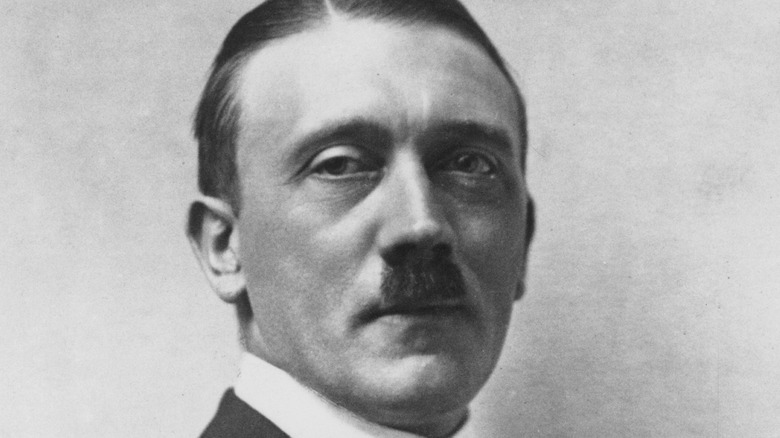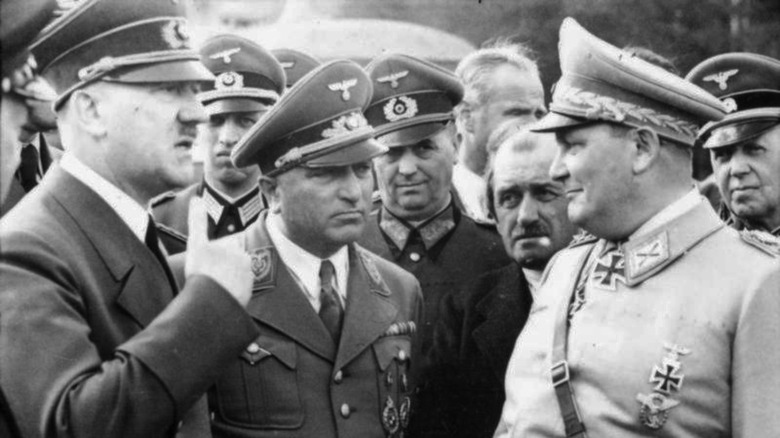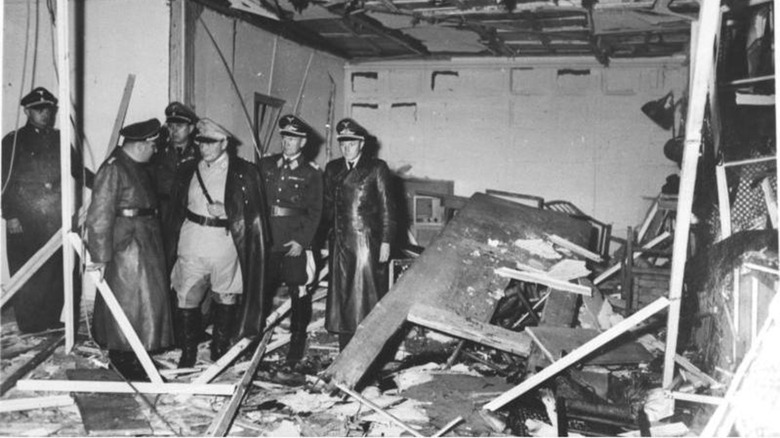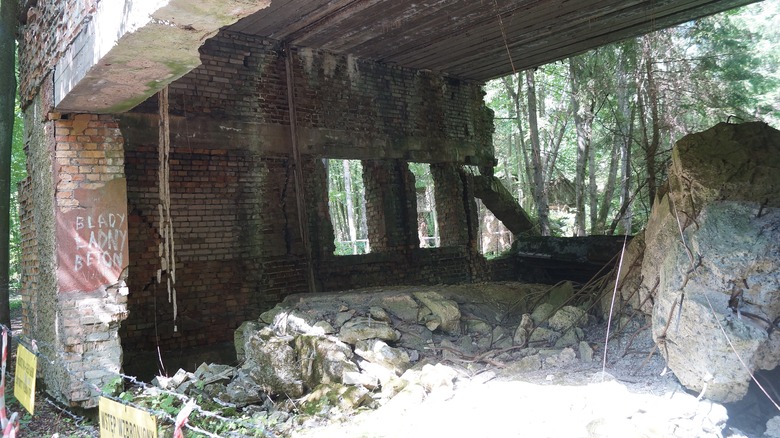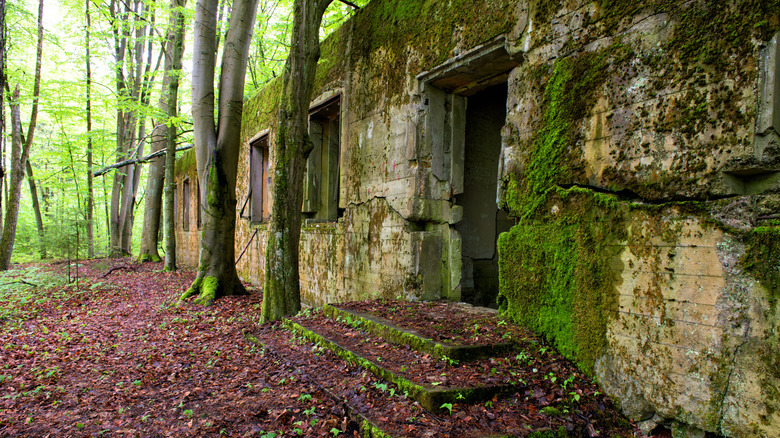What You Might Not Know About Hitler's Wolf's Lair
You may already know that Adolf Hitler, the dictator of Germany from 1933 to 1945, kept his official residence at the Reich Chancellery in Berlin, which he later renamed the "Führerwohnung," per Love Money. However, the so-called "Führer" wasn't content with just one residence. Located out of sight, deep in the Masurian woods in what was then East Prussia (now present-day Kętrzyn, Poland), Hitler spent over 800 days, or almost half of World War Two, in Wolf's Lair, the secret command post that served as Germany's military headquarters for the Eastern Front. From this fortified post, Hitler devised military strategies designed to help him invade European nations, as well as planned the construction of the infamous Death Camps, per Globotreks.
According to Wolfsschanze, the location was selected for its many strategic advantages. First and foremost, it was a secure spot, hidden on almost all sides by forest, as well protected on the east by the Great Masurian Lakes. These natural obstacles were then additionally fortified using resources like anti-tank trenches, barbed wire fences, and landmines scattered throughout the property. Its position near the border of the Soviet Union inside the most strongly fortified region of East Prussia also made it the perfect place for Hitler's Eastern Front command post.
Hitler employed taste testers at Wolf's Lair
With over 80 buildings and more than 30 bunkers spread out over two-and-a-half square miles of land, Wolf's Lair required quite a few employees to keep the residence up and running. While the Lair itself could fit around 2,000 people, including high-ranking Nazi officers like Hermann Göring, Heinrich Himmler, and Joseph Goebbels, it also housed live-in employees, not all of whom were Nazis themselves, to manage operations around the camp.
Per Wolfsschanze, at least 3,000 to 5,000 people were employed at Wolf's Lair, although the true number may have even been higher. Among the employees were many young women who worked as taste testers, sampling Hitler's food before it was served to him to ensure it hadn't been poisoned. "Some of the girls started to shed tears as they began eating because they were so afraid. We had to eat it all up. Then we had to wait an hour, and every time we were frightened that we were going to be ill. We used to cry like dogs because we were so glad to have survived," Margot Wölk, the only food taster to have survived the war, recounted to The Independent in 2018.
A plot to kill Hitler was carried out in Wolf's Lair
However, while Hitler may have been hyper-focused on maintaining security, that didn't prevent an assassination attempt from occurring inside the heavily fortified Wolf's Lair. On July 20, 1944, a Staff Officer, Colonel Claus von Stauffenberg, put into place a plan to kill the dictator. Dubbed "Operation Valkyrie" or the "20 July Plot," von Stauffenberg smuggled a bomb hidden inside his briefcase, which he intended to explode during a meeting held in a conference room at Wolf's Lair.
However, the plan was foiled at the last minute when another officer pushed the briefcase containing the bomb to the edge of the conference room table. When it finally detonated at 12:42 PM, the blast was obscured by the heavy table, shielding Hitler from the worst of the explosives. Although Hitler survived, four others died and many more were injured, per BBC. Once the plot to kill Hitler was exposed, Claus von Stauffenberg was executed by firing squad, along with almost 200 other Germans who had also been put to death for their involvement in the plan.
Hitler gave orders for Wolf's Lair to be destroyed
The Red Army's continued advancements into East Prussia forced Hitler and his officers to abandon their command post at Wolf's Lair on November 20, 1944, according to Wolfsschanze. In January of 1945, Hitler ordered the buildings at Wolf's Lair destroyed. Using thousands of tons of TNT, SS officers attempted to blow up the former command post but were unsuccessful. Despite all the damage, many of the sturdy bunkers remained standing even after they had been struck with explosives. However, the land mines that had been spread throughout the grounds for security reasons remained active until around the mid-1950s, when the area was finally cleared, according to Love Money.
As a result, Wolf's Lair was simply abandoned following Hitler's suicide on April 30, 1945, and Germany's subsequent surrender to the Allied Powers. Without anyone maintaining the grounds, nature eventually began to overrun much of Wolf's Lair as time passed. However, perhaps understandably, it remained a site of much interest to the public, often drawing unofficial tourists to the place who were intrigued by the area's dark history.
Wolf's Lair is now open to the public
In 2017, the Polish Forestry Inspectorate took control of Wolf's Lair, turning it into an historic — although not totally uncontroversial — informational tourist site. While some believe that it is important for people to learn about the significant history attached to the area, others fear that Hitler's former outpost may serve as a rallying point for Neo-Nazis and others who seek to honor, rather than condemn, Hitler's actions. However, tour guides say very few Neo-Nazis visit the site these days. "That's really just a few, not more than a few percent. Neo-Nazis don't really come here," Jerzy Szynkowski, a Wolf's Lair tour guide, told the DW.
Today, interested visitors can take official tours of the site, read education placards detailing the events that took place in the bunkers, and learn about the history of Wolf's Lair. Only a single bunker, which once housed Hitler's personal security, remains completely intact, now serving as a small restaurant and hotel, according to Globotreks. Bunker number 13, which was once Hitler's personal bunker, is still standing, although the exterior has suffered some damage and the interior has been completely destroyed. The site also includes a memorial to Colonel Claus von Stauffenberg, as well as numerous other artifacts. Today, around 300,000 tourists visit the site every year, per the BBC.
